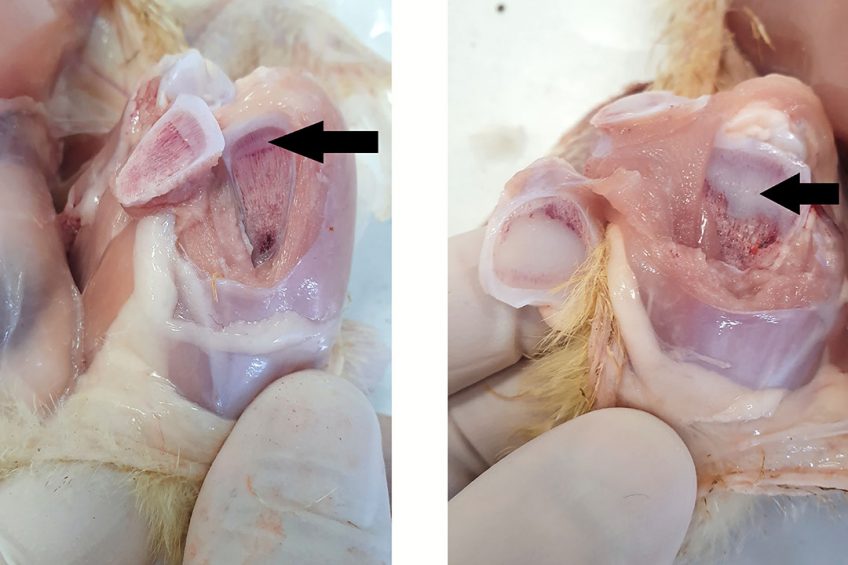Phosphate not calcium for better bone formation in poultry

Recent research shows that it is not the calcium, but the phosphate level that has a strong correlation with bone formation.
Each link in the production chain contributes to the development of a healthy broiler. This also applies to the compound feed. On a daily basis, feed industry nutritionists work to optimise the feed with the help of new insights which, among other things, can help to improve bone formation.
In nature a certain optimum often turns out to offer the best results. More is not always better. This also applies to nutrition. A diet must provide a certain balance between the different nutrients in order to achieve an optimum result. Sometimes it is difficult to find the right balance because one nutrient counteracts the effect of another. This applies to calcium, for example. Calcium is seen as an important building block for bone formation and, among other things, is added to the diet in the form of chalk. Chalk increases the pH in the stomach, where protein is then not digested well as a result. This in turn has a negative impact on daily growth and the feed conversion. An excessively generous addition of chalk to the feed therefore leads to poorer technical results.
How is bone formed?
Bone is formed from calcium and phosphate, among other things. Vitamin D3 plays a key role in this process. There also needs to be a certain balance between the calcium and the phosphate. In the bone (hydroxyapatite) salts of calcium and phosphate are deposited in a fixed ratio. Therefore, calcium and phosphate also need to be present in the diet in a fixed ratio. Calcium and phosphate can be added to the diet by adding various raw materials. Chalk is a well-known source of calcium and monocalcium phosphate is an important source of calcium and phosphate.
In addition to phytase, organic and other additives are also available which can influence the amount of calcium or phosphate in the diet.
The question is: what ratio of calcium and phosphate sources yields the best bone formation, while maintaining body growth?
The Dutch compound feed company Gebrs. Fuite BV and the Health Center for Poultry conducted a study to find an answer to this question.
Laboratory research focused on broilers
The study focused on bone formation in broilers in the first week of life. Chicks from 14 broiler farms (with chicks from different parent stock farms) were sent to the laboratory for monitoring research. In addition to a normal section the chicks were examined for a number of parameters that provide an indication of the quality of bone formation. For example, the researchers determined the sex, weight, length of the gastrointestinal tract, the yolk residual weight, the breaking strength of the upper leg bone, the lower leg bone and the tread bone, the width of the growth plates and whether or not the femoral head broke during luxation.
The levels of calcium, as well as organic and inorganic phosphate in the blood were also analysed. In this way, the different parameters were correlated to 3 different types of starter feed. All the data were then analysed using a statistical model.
Hens have better bone formation
The results (see Table 1) showed that some parameters are strongly related to the quality of bone formation. One of these parameters is the sex of the chick. Hens have better bone formation than males (independent of body weight). It is striking that hens also have a higher phosphate level in the blood. A higher phosphate level (regardless of gender) appears to be significantly (p <0.005) correlated with better bone formation and with higher body weight. Roosters generally have a lower level of phosphate in the blood as well as poorer bone quality. However, a higher calcium level in the blood had less influence on better bone formation in both males and females. What was also striking in this study is that a higher pH in the stomach was associated with a higher calcium level in the blood, yet it was not associated with a higher phosphate level in the blood.
Phosphate ‘promotes’ bone formation
The research led to a number of surprising insights. It was expected that hens would have better bone quality. But the fact that this was related to higher blood phosphate levels and less to higher blood calcium levels was a surprise. Furthermore, it appeared that a higher pH in the stomach was associated with higher calcium levels in the blood, but this had less effect on bone quality. Higher phosphate levels were positively correlated with body weight, although a causal relationship could not be established in this study. In conclusion, it appears that it is not the calcium, but the phosphate level which is a more important factor to take into account when optimising broiler feed, in particular, to ensure proper bone formation.











